Test Bank For Introduction to Medical-Surgical Nursing 6th Edition by Linton
Chapter 01: The Health Care System
Linton: Introduction to Medical-Surgical Nursing, 6th Edition
MULTIPLE CHOICE
1. An 89-year-old man, who was recently discharged from a rehabilitation hospital because of an inability to concentrate and frequent memory lapses, cannot be left alone while his family works. What options should the discharge planning team suggest that will satisfy safety concerns and give the greatest quality of life to the patient?
- Placement in a day care center from 8 AM to 5 PM daily
- Placement in a long-term psychiatric facility
- Placement in a high-security nursing home
- Admission to a general hospital for evaluation
ANS: A
Day care centers provide supervision, safety, nutritious meals, and socialization while the caregiving family works.
DIF: Cognitive Level: Application REF: p. 7 OBJ: 5
TOP: Day Care Centers KEY: Nursing Process Step: Planning MSC: NCLEX: Physiological Integrity: Reduction of Risk
2. A 66-year-old hospitalized patient is anxious about how the physician will be paid now that he is on Medicare Parts A and B, instead of his previous privately funded insurance plan. Who should the nurse explain is the payor to the physician on this plan?
a. Previous privately funded insurance plan
- Medicare Part A
- Medicare Part B
- Patient or patient’s family
ANS: C
Part A pays skilled care facilities. Part B pays for physician’s services. The previously held insurance is no longer available because of the patient’s age. The family or patient is not responsible because Part B is in effect.
DIF: Cognitive Level: Comprehension REF: p. 11 OBJ: 4
TOP: Health Care Funding KEY: Nursing Process Step: Implementation MSC: NCLEX: Safe, Effective Care Environment: Coordinated Care
3. What health care plan is the best referral for an unemployed 42-year-old patient with renal failure who has lost his job-related private insurance?
- Medicare
- Medicaid
- Public health facility
- Community-based outpatient clinic
ANS: B
Medicaid is available to needy low-income persons younger than 65 years of age who have a permanent disability. Medicare is for persons 65 years and older. Public health services are involved with prevention more often than with chronic care.
Introduction to Medical-Surgical Nursing 6th Edition Linton Test Bank
DIF: Cognitive Level: Comprehension REF: p. 11 OBJ: 4
TOP: Health Care Funding KEY: Nursing Process Step: Implementation MSC: NCLEX: Safe, Effective Care Environment: Coordinated Care
4. A patient with terminal lung cancer with extensive metastasis is requesting a hospice transfer. What criteria are included as requirements for this transfer?
- The patient requests and agrees to the guidelines of hospice care without requiringa physician’s order.
- The physician confirms that the patient has 6 months or less of life remaining andhas provided a written order for hospice care.
- Proof confirms that the family can no longer care for the patient at home.
- The patient’s specific diagnosis is included on a list of accepted diseases thatqualifies the patient for hospice care.
ANS: B
The four criteria for transfer to hospice care are (1) diagnosis of any terminal illness, (2) prognosis of less than 6 months of life, (3) informed consent of patient, and (4) written physician’s order.
DIF: Cognitive Level: Comprehension REF: p. 7 OBJ: 5
TOP: Hospice Care KEY: Nursing Process Step: Implementation MSC: NCLEX: Physiological Integrity: Basic Care and Comfort
5. A patient admitted yesterday with a diagnosis-related group (DRG) diagnosis of abdominal pain of an unknown cause is being discharged this afternoon because all diagnostic test results have been negative. What does this scenario exemplify?
a. Effective laboratory response
b. Medicare guidelines limiNtingRhosIpitaGl staBy.C M USNT O
c. Cost containment related to a DRG diagnosis
d. Patient who should not have been admitted in the first place
ANS: C
Cost containment is a means by which the cost of hospitalization time is reduced when the need for acute hospital care is no longer necessary.
DIF: Cognitive Level: Comprehension REF: p. 11-12 OBJ: 6 TOP: Cost Containment per DRGs KEY: Nursing Process Step: N/A MSC: NCLEX: N/A
6. A nurse is discussing discharge to a transitional subacute facility with a 72-year-old patient diagnosed with diabetes and bilateral leg amputation. What should the nurse inform the patient regarding the stay in the new facility?
- It will be limited to 25 days.
- It will be limited to 50 days.
- It will be limited to 75 days.
- It is totally unlimited.
ANS: D
Medicare limitations are waived for patients who have undergone amputations.
DIF: Cognitive Level: Comprehension REF: p. 8 OBJ: 4
TOP: Stay in a Skilled Care Facility KEY: Nursing Process Step: Planning
Introduction to Medical-Surgical Nursing 6th Edition Linton Test Bank
MSC: NCLEX: Safe, Effective Care Environment: Coordinated Care












Reviews
There are no reviews yet.